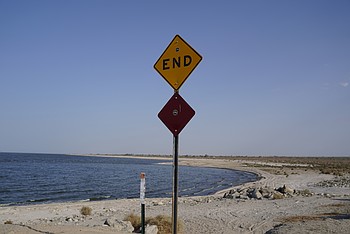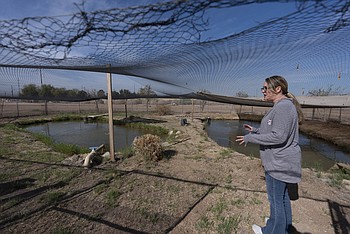'You can scream all you want. Nobody cares'
ELLIOT SPAGAT/Associated Press | Hagadone News Network | UPDATED 9 years, 9 months AGO
SALTON CITY, Calif. - Once-bustling marinas on shallow water in California's largest lake a few years ago are bone-dry. Carcasses of oxygen-starved tilapia lie on desolate shores. Flocks of eared grebes and shoreline birds bob up and down to feast on marine life.
An air of decline and strange beauty permeates the Salton Sea: The lake is shrinking - and on the verge of getting much smaller as more water goes to coastal cities.
San Diego and other Southern California water agencies will stop replenishing the lake after 2017, raising concerns that dust from exposed lakebed will exacerbate asthma and other respiratory illness in a region whose air quality already fails federal standards. A smaller lake also threatens fish and habitat for more than 400 bird species on the Pacific flyway.
Many of the more than 10,000 people who live in shoreline communities cherish the solitude but now feel forgotten. The dying lake must compete for water as California reels from a four-year drought that has brought sweeping, state-ordered consumption cuts.
Julie Londo, who moved to Salton City after visiting in 1986 from Washington state, hopes for help for the periodic, rotten odor from the lake that keep residents inside on hot, fly-filled summer nights. The stench in 2012 carried more than 150 miles to Los Angeles.
"Unfortunately, that's the only time anyone will listen because we don't have a voice," Londo, 60, said on her porch, one of the few that still lies a stone's throw from water. "You can scream all you want. Nobody cares."
San Diego now purchases more than one-quarter of its water from California's Imperial Valley, where fields produce runoff that delivers 70 percent of the lake's inflows. More water for San Diego means less for the Salton Sea.
In 2003, the state Legislature agreed to spearhead efforts to restore the lake to help seal the San Diego sale. California, which used more Colorado River water than it was entitled to, was under enormous pressure to go on a water diet after Sunbelt cities like Phoenix and Las Vegas clamored for their share.
The San Diego County Water Authority and other local agencies agreed to deliver water to the Salton Sea for 15 years while the state developed a long-term fix. This year, that water accounts for 10 percent of the lake's inflows.
With no fix in sight, the Imperial Irrigation District asked state regulators in November to condition San Diego sales on the state fulfilling its promise, citing the state legislation and the state's open-ended contractual commitment to pay for offsetting environmental damage.
The 2003 contract to sell water to San Diego for up to 75 years still deeply divides Imperial Valley farmers, who grow much of the nation's winter vegetables.
Imperial Valley gets nearly 20 percent of Colorado River water distributed in the western United States and northern Mexico - enough for more than 6 million households - but some growers fear cities will eventually suck their fields dry.
Viewed from the air, the Imperial Valley's half-million acres of verdant fields end abruptly in pale dirt. Colorado River water is diverted near Yuma, Ariz., to an 82-mile canal that runs west along the Mexican border and then north into 1,700 miles of gated dirt and concrete channels that crisscross farms.
When gates open, water floods fields and gravity carries increasingly salty runoff downhill through the New and Alamo rivers to the Salton Sea.
The lake has suffered a string of catastrophes since tropical storms in the late 1970s destroyed houses, marinas and yacht clubs, ending an era of international speedboat races and glamor that once drew more visitors than Yosemite National Park. Botulism killed large numbers of pelicans in 1996.
Fish kills have happened regularly since nearly 8 million croaker and tilapia died in 1999. The water is nearly twice as salty as the Pacific Ocean, endangering remaining tilapia. Winds that stir hydrogen sulfide gas from the lake's bottom strips oxygen from surface waters where fish swim and creates stenches similar to rotten eggs.
The lake's fragile state was on display one spring afternoon as thousands of tilapia washed ashore. A white mist rising from the placid waters was evaporation. Great blue herons took flight, while American coots skimmed the surface.
MORE IMPORTED STORIES

Lithium fuels hopes for revival on California's largest lake
Daily Inter-Lake | Updated 3 years, 7 months ago

Tiny, endangered fish hinders California's Colorado River conservation plan
Daily Inter-Lake | Updated 12 months ago
Wildfire burns homes in Southern California desert town
Columbia Basin Herald | Updated 4 years, 8 months ago
ARTICLES BY ELLIOT SPAGAT/ASSOCIATED PRESS

'You can scream all you want. Nobody cares'
California's largest lake threatened by urban water transfer
SALTON CITY, Calif. - Once-bustling marinas on shallow water in California's largest lake a few years ago are bone-dry. Carcasses of oxygen-starved tilapia lie on desolate shores. Flocks of eared grebes and shoreline birds bob up and down to feast on marine life.

